Bathing a cat can be a daunting task, especially when your feline friend vehemently despises water. However, with the right approach and a little patience, it is possible to give your water-hating cat a bath without trauma.
In this article, we delve into the world of feline bath time struggles, exploring the reasons behind their aversion to water and offering practical tips and techniques to make the experience as stress-free as possible.
Whether you’re a seasoned cat owner or a first-time caregiver, arming yourself with the knowledge and strategies outlined here will help you navigate the treacherous waters of cat bathing with confidence and compassion.
Importance Of Maintaining Proper Cat Hygiene:
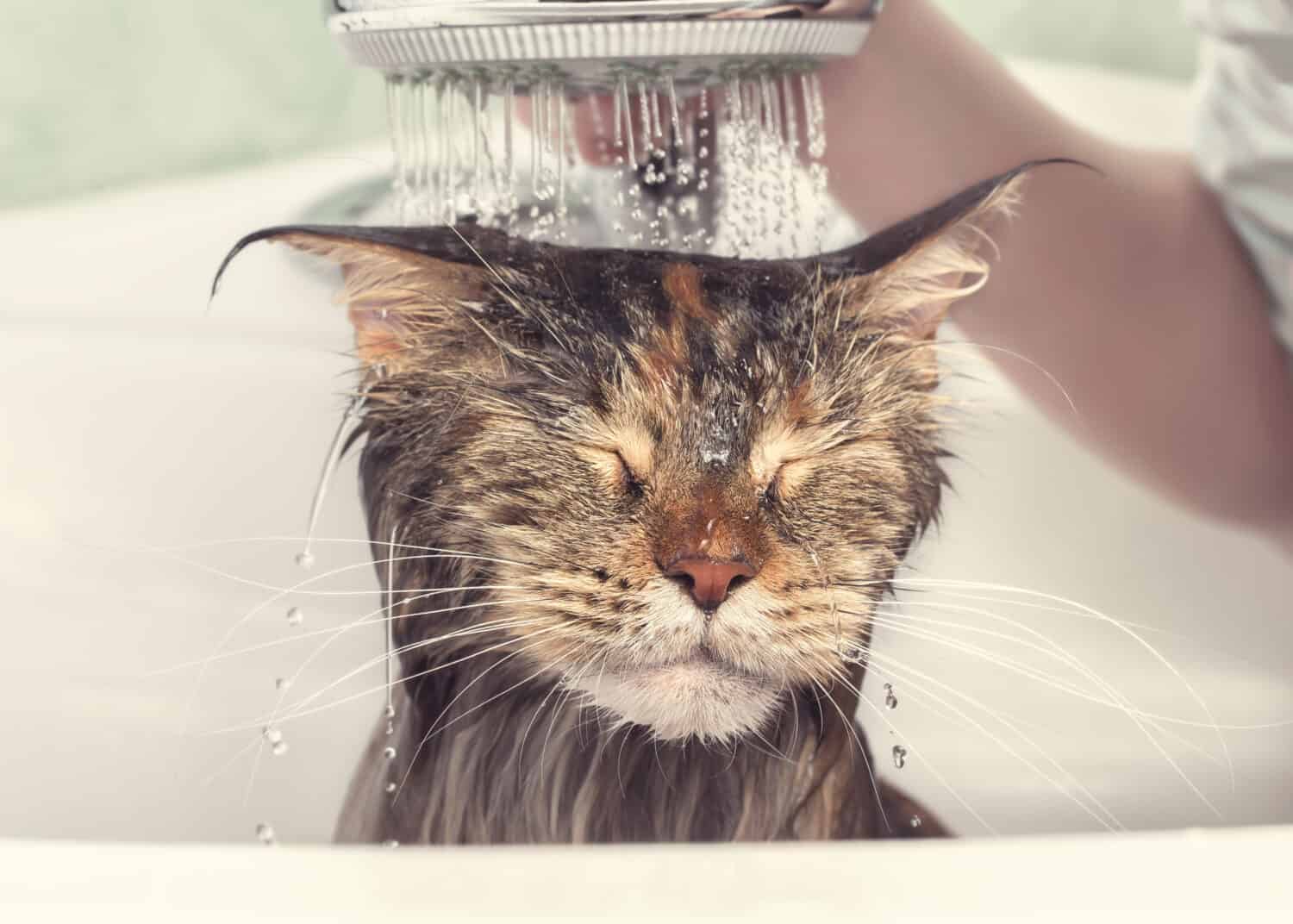
Proper hygiene is vital for a cat’s overall health.
©Olleg Visual Content/Shutterstock.com
Proper cat hygiene is essential for the overall health and well-being of our feline companions. Regular grooming, including bathing, helps keep their fur clean, free from matting and tangles, and reduces the risk of skin infections.
Cats are meticulous self-groomers, but there are instances when they may need a little extra help in maintaining their hygiene. Bathing not only helps to remove dirt, debris, and odors from their coat but also assists in controlling issues like allergies, fleas, and skin irritations.
By prioritizing proper cat hygiene, we can ensure that our furry friends are comfortable, happy, and free from any discomfort caused by poor cleanliness.
Why Do Cats Dislike Water?
Cats and water have always had a complicated relationship, but have you ever wondered why? It turns out that their aversion to water can be traced back to their desert-dwelling ancestors. Over time, cats have developed a strong instinct to stay dry, as their coats are not designed to repel water effectively. Understanding this evolutionary quirk can help us approach bath time with compassion and find ways to ease their fear.
Signs Of Fear During Bath Time
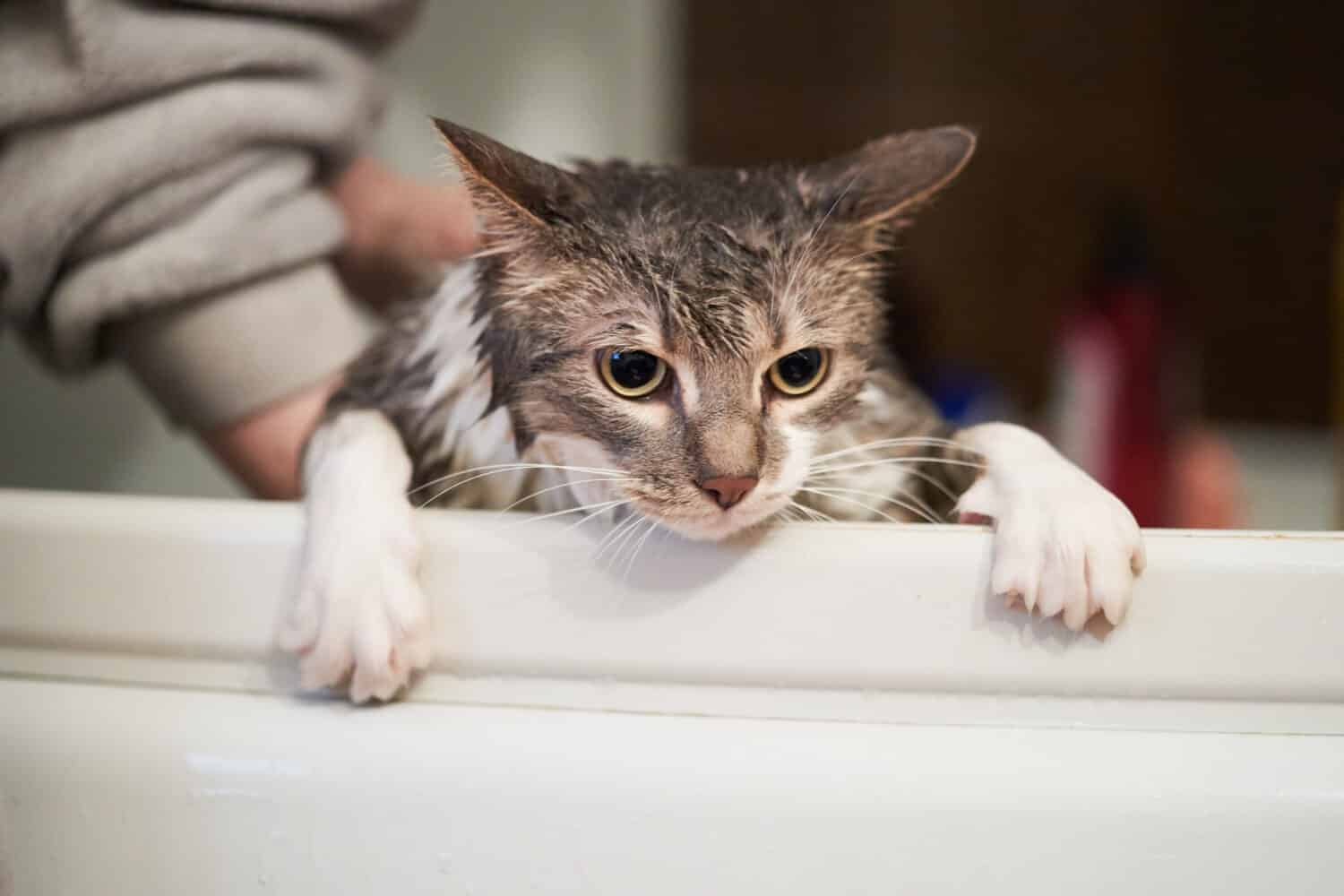
Clawing, scratching, hissing, growling, and dilated pupils are all signs a cat hates taking a bath.
©JSep/Shutterstock.com
Bath time for cats can be a nerve-wracking experience, and they often display clear signs of fear or anxiety. By recognizing these signals, we can ensure their well-being and minimize stress. Look out for:
- Flattened ears
- Dilated pupils
- Hissing
- Growling
- Whining
- Attempting to flee
- Defensive behaviors like scratching or biting
By paying attention to their body language and vocalizations, we can adapt our approach and create a more serene environment for our feline friends.
Step 1: Preparing for the Bath
To ensure a successful bath time experience for both you and your feline friend, it’s crucial to create a calm and safe environment. Here are a few essential steps to follow:
Find a Quiet Space:
Choose a quiet room with minimal distractions where you can set up your bathing area. This will help keep your cat relaxed and focused during the process.
Secure the Area:
Remove any potentially harmful objects or chemicals from the room. Close windows and doors to prevent escapes or accidents. Consider using a non-slip mat in the bathing area to provide stability for your cat.
Dim the Lights:
Lowering the lights or using soft, indirect lighting can help create a soothing atmosphere and reduce your cat’s anxiety.
Play Soothing Music:
Soft, calming music can help mask any external noises and soothe your cat’s nerves. Classical or instrumental music often works well.
Use Familiar Scents:
Consider using pheromone sprays or diffusers specifically designed for cats. These products emit calming scents that can help alleviate stress and anxiety.
Step 2: Gathering Necessary Supplies for the Bath
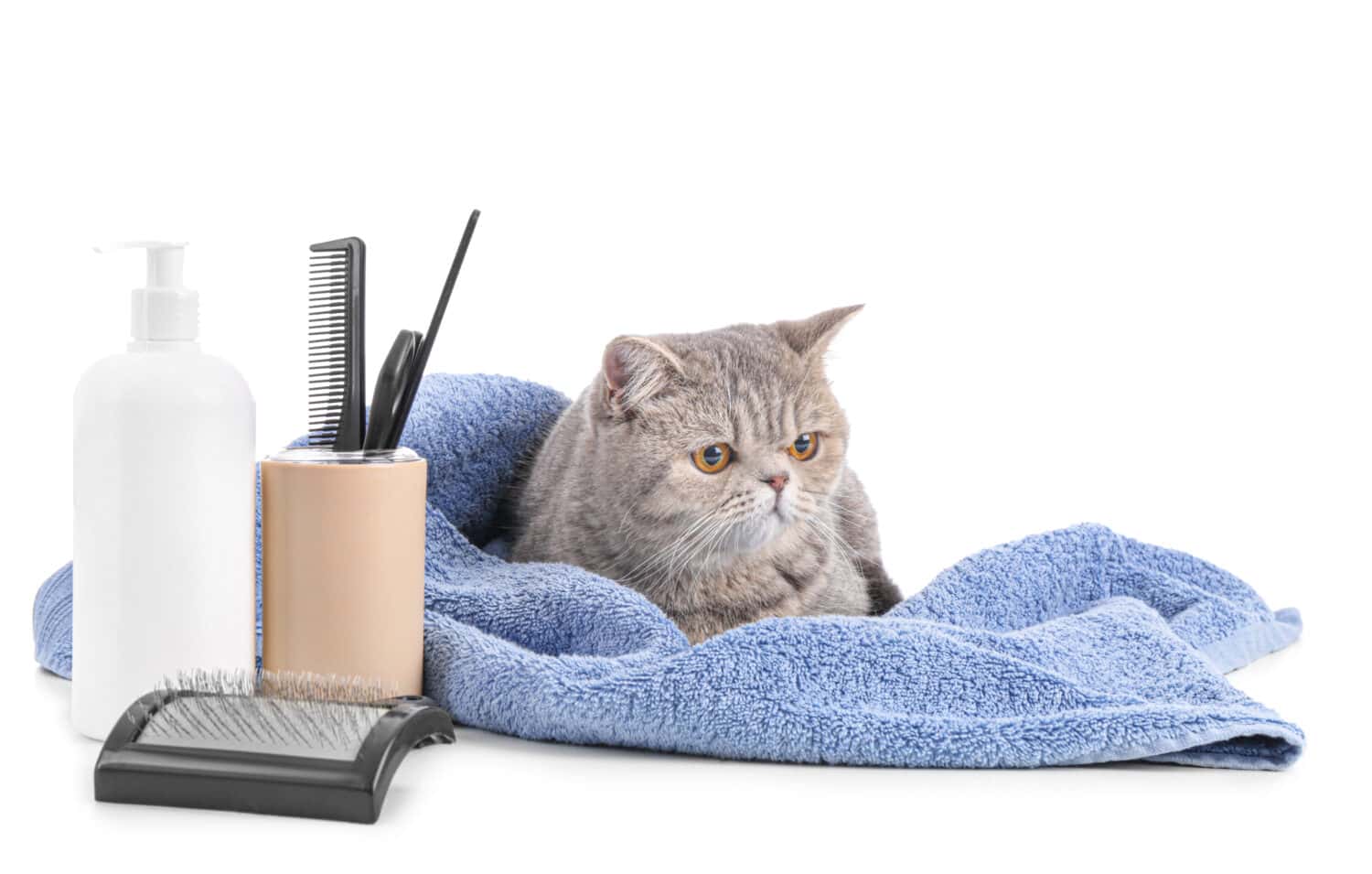
Make sure you have all the essential grooming supplies ready before you start bathing your cat.
©Pixel-Shot/Shutterstock.com
Before starting the bathing process, ensure you have all the necessary supplies within reach. This will help streamline the process and minimize any unnecessary stress for your cat. Here’s a checklist of items to have on hand:
Cat-Friendly Shampoo:
Choose a shampoo formulated specifically for cats. Avoid using products meant for humans or dogs, as they can be harmful to your cat’s delicate skin.
Rinse Cup:
Have a decent-sized cup (16 to 24 oz) to use for rinsing the cat as you bathe. This is more calming than having the water run or using a sprayer. If you do use a sprayer, make sure it is on a low setting and the water is not too hot.
Towels:
Have a stack of soft, absorbent towels ready to dry your cat after the bath. Consider warming them in a dryer beforehand for added comfort.
Grooming Tools:
Depending on your cat’s coat type, gather any necessary grooming tools like a comb or brush to help remove tangles or mats before the bath.
Protective Gear:
Consider wearing protective gloves to protect yourself from scratches or bites. However, always prioritize your cat’s comfort and well-being over the use of protective gear.
Step 3: Introducing Your Cat to the Bathing Area Gradually
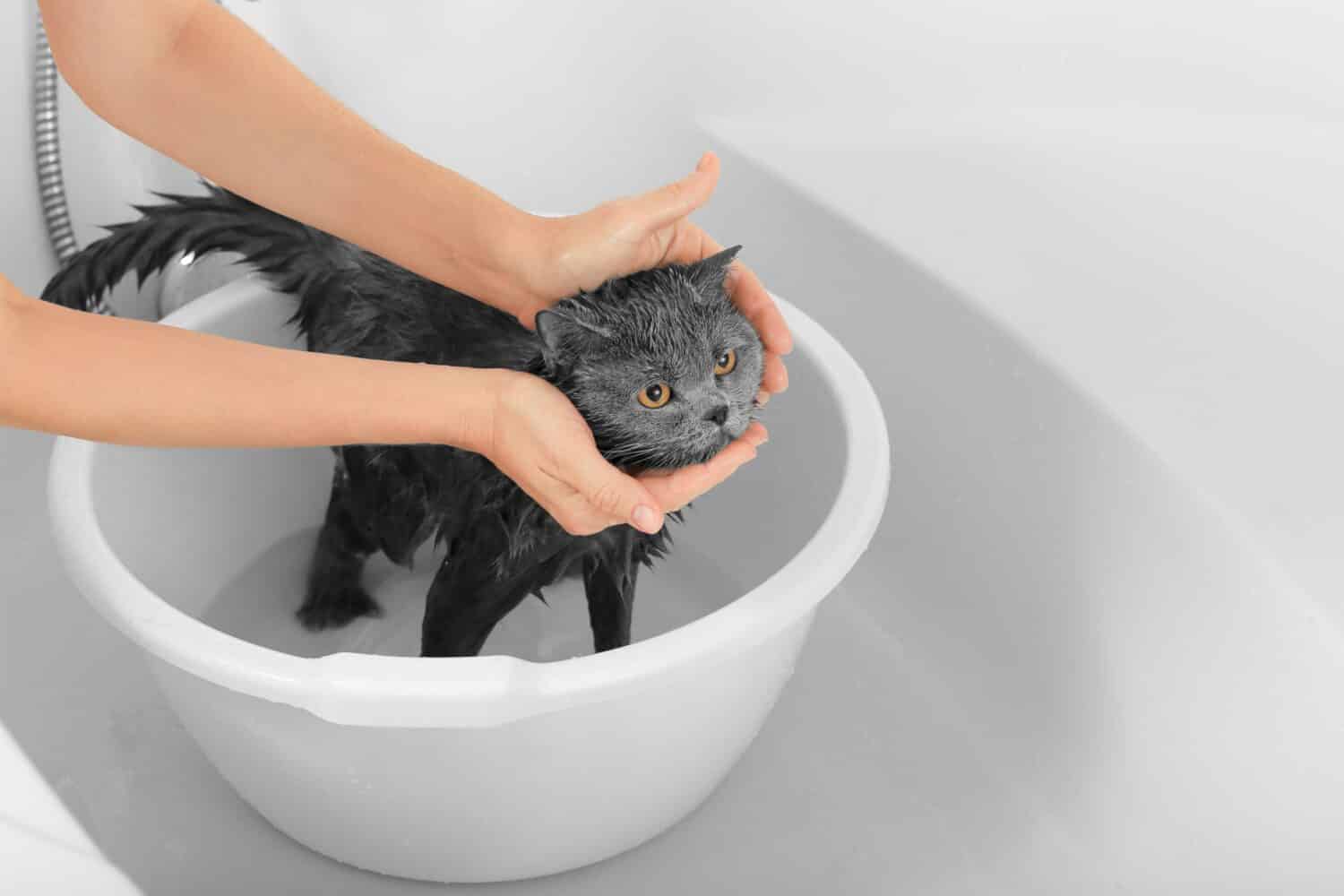
Using a smaller bin than your tub to bathe your cat can help ease a cat’s water anxiety.
©Zulkarnieiev Denis/Shutterstock.com
Introducing your cat to the bathing area gradually can help reduce their anxiety and make the process smoother. Try the following steps:
Familiarize Your Cat:
Allow your cat to explore the bathing area freely before the bath. Let them sniff and investigate the space to become more comfortable.
Positive Associations:
Offer treats or praise while your cat is near the bathing area to create positive associations. This will help them associate the space with rewards and reduce their fear or resistance.
Gradual Approach:
Start by introducing your cat to the water slowly. Use a damp cloth or sponge to gently stroke their fur, gradually increasing the wetness over time. This gradual approach can help your cat adjust to the sensation of water.
Use A Shallow Basin or Sink:
Using a shallow basin or sink instead of a full bathtub can be helpful so they don’t become overwhelmed with too much water. Fill it up prior to putting the cat in versus leaving the water running while you bathe them. Make sure the water is not hot, but more lukewarm to the touch.
Step 4: Bathing Your Cat
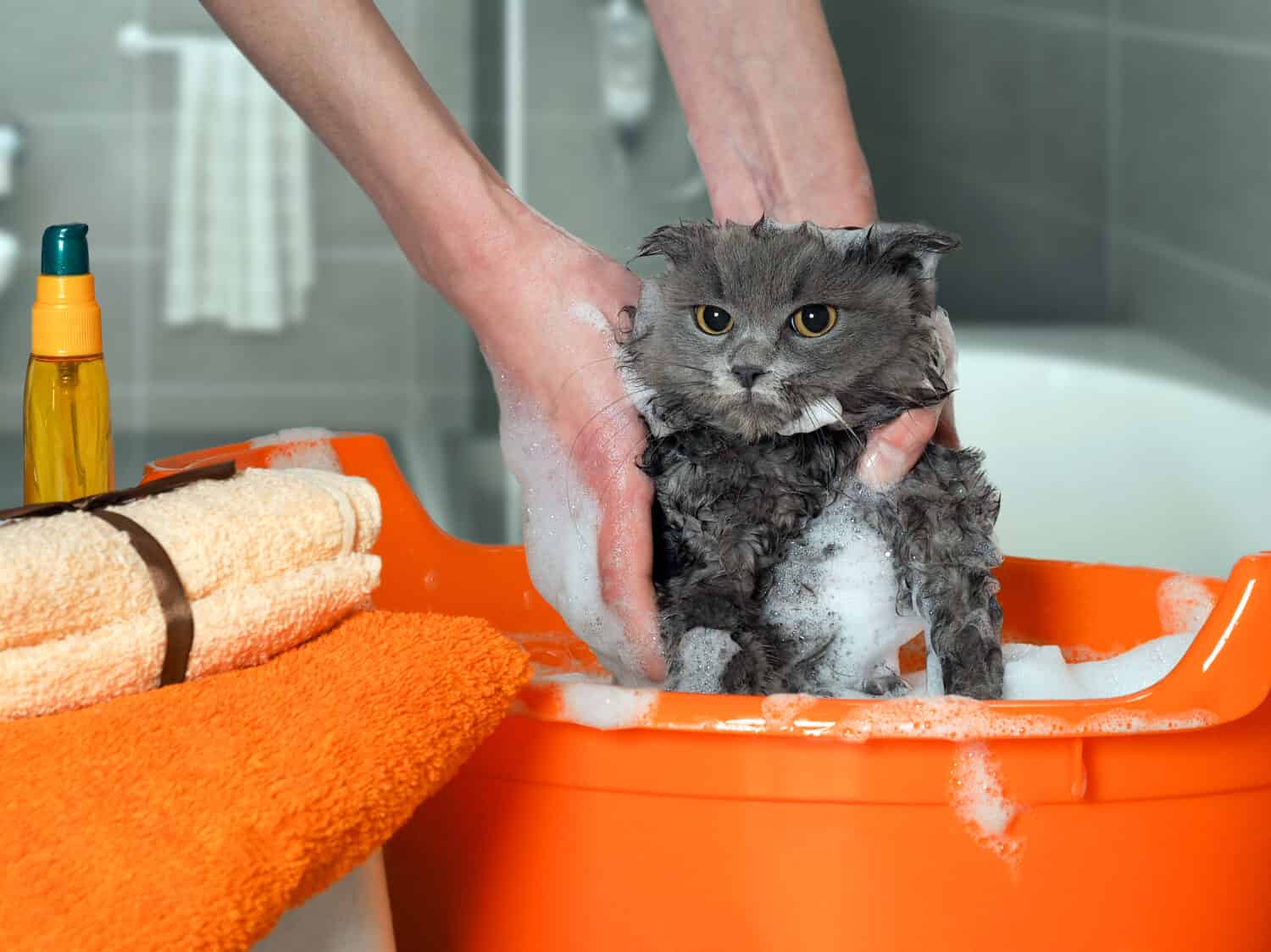
A slow and gentle approach is best when bathing a cat.
©Irina Kozorog/Shutterstock.com
Gently Place the Cat in the Water:
Lower your cat into the warm water slowly and gently, supporting its body with one hand. Make sure to keep a firm grip on your cat to prevent them from escaping or getting scared. Avoid splashing water on their face, as cats generally don’t like having water on their heads.
Wet the Cat’s Fur:
Use your free hand or a cup to pour water over your cat’s body, excluding the head. Start from the neck and work your way down, ensuring that the fur is thoroughly wet. Avoid pouring water directly onto the cat’s face.
Apply Cat-Friendly Shampoo:
Once the cat’s fur is wet, apply a small amount of cat-friendly shampoo to your hand and lather it gently through their fur, starting from the neck and working your way down. Be sure to use a shampoo specifically formulated for cats to avoid skin irritation or harm.
Rinse the Shampoo:
Using a cup or your hand, pour clean warm water over the cat’s body to rinse off the shampoo. Repeat this process until all the shampoo is removed and the water runs clear.
Dry the Cat:
After rinsing, gently lift the cat out of the water and place them on a towel. Blot their fur with a dry towel to remove excess water. If your cat tolerates it, you can use a hairdryer on a low, warm setting to help dry their fur. However, ensure the noise doesn’t frighten or stress them.
Tips for Post-Bath Care

Be sure to towel dry your cat immediately and thoroughly after bathing to avoid hypothermia.
©KDdesignphoto/Shutterstock.com
After you finish bathing your cat, there are a few simple tips you can follow to make sure you end the experience on a positive note:
- Dry your cat immediately and thoroughly to prevent discomfort or illness
- Reward your cat with treats or playtime after the bath
- Monitor your cat’s behavior and health following the bath
The Power of Patience and Understanding
When dealing with a fearful cat, patience and empathy are paramount. Cats are delicate creatures and forcing them into uncomfortable situations can have lasting negative effects. By approaching bath time with patience, we allow them to adjust at their own pace.
Offering reassurance through gentle strokes, soothing words, and treats can help build trust and foster a positive association with bathing. Remember, each cat is unique, so it’s important to tailor our approach to their individual fears.
Dealing with Extreme Cases
When dealing with extreme cases where no amount of patience or effort seems to work, it might be best to seek out help from a groomer or veterinarian if they are in need of a thorough cleansing. If they just need a bit of extra help, you may be able to get away with some at-home alternative methods to a traditional bath.
Alternative Methods to Traditional Cat Bathing:
Dry Shampoo or Waterless Shampoo Options
Dry shampoo or waterless shampoo is a convenient alternative to traditional cat bathing, especially if your cat is not a fan of water. Here are the steps to use dry shampoo or waterless shampoo:
Brush your cat: Before applying the dry shampoo, brush your cat’s fur thoroughly to remove any loose dirt or tangles.
Apply the shampoo: Spray or apply the dry shampoo or waterless shampoo foam onto your hands or directly onto your cat’s fur. Avoid applying the shampoo near your cat’s face, eyes, mouth, or ears.
Rub it in: Gently rub the dry shampoo or waterless shampoo into your cat’s fur, making sure it reaches the skin. Massage it in, working from the neck down to the tail. Follow the product instructions for the recommended amount to use.
Let it sit: Allow the dry shampoo or waterless shampoo to sit on your cat’s fur for a few minutes. This will help the shampoo absorb any oils and dirt.
Brush it out: After the shampoo has had time to work, use a brush or comb to remove the dry shampoo from your cat’s fur. This will help remove any dirt and excess product from the fur.
Towel dry (if necessary): If your cat’s fur feels damp after using waterless shampoo, gently towel dry its fur to remove any excess moisture.
Wet Wipes or Damp Towels for Spot Cleaning
If you need to clean specific areas on your cat, wet wipes or damp towels can be useful. Here’s how to use them:
Choose pet-safe wipes: Look for wet wipes specifically formulated for pets, as they are gentle on their skin and fur. Avoid using wipes that contain harsh chemicals or fragrances.
Dampen the wipes or towels: If using towels, dampen them with lukewarm water. If using wet wipes, ensure they are moist but not dripping.
Spot clean: Gently wipe the desired areas on your cat’s body where cleaning is needed. This can include paws, face, or fur stains. Be careful around sensitive areas such as eyes, ears, and genitals.
Pat dry: After spot cleaning, pat the cleaned areas dry with a clean towel or allow them to air dry naturally.
Remember to always choose products that are safe for cats and avoid using any harsh chemicals or ingredients that could irritate their skin. Additionally, if your cat has specific skin conditions or sensitivities, it’s best to consult with a veterinarian for appropriate cleaning methods and products.
The photo featured at the top of this post is © BBbirdZ/Shutterstock.com
Thank you for reading! Have some feedback for us? Contact the AZ Animals editorial team.







